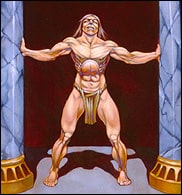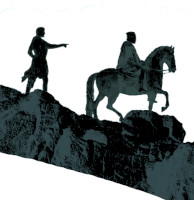As I am writing a series of articles on epic narrative I found myself re-writing in my mind a piece I did ten years ago for an ancient history book. If you’d like to read more check out The Broken Dance on the Ancient Combat page.
Seven, the Number of the Hero
“…And Enkidu took her.
She did not recoil, but tempted him…
…she taught the wild-man the woman’s art
And he was attracted to her and joined with her.
For six days and seven nights Enkidu coupled with the whore.”
—The Epic of Gilgamesh
After being tamed by the woman Enkidu becomes destined to rival and then serve Gilgamesh, who, like all heroic tyrants since, could not cut a heroic figure without lesser heroes to illuminate his deeds. Without Joe Frazier and George Foreman we wouldn’t have had such a great Muhammad Ali. Likewise, without Enkidu, the Epic of Gilgamesh would have been just another bronze-age boast inserted into a pedestrian kings list by a paid hack.
Such movies as Tears of the Sun, Dog Soldiers, Predator, The Magnificent Seven, The Expendables, and Seven Samurai are built around the ancient idea of seven doomed heroes. Older tales such as J.R.R. Tolkien’s Lord of the Rings, Aeschylus’ Seven Against Thebes and various creation and flood stories imbedded in near eastern myth point to the depth of this tradition.*
The seven heroes of myth may simply be built around the idea of seven sacred days which derives from the seven visible moving heavenly bodies, forming the basis for the week as a division of the lunar month. There is also the question of the relation of the number seven to geographic and city-planning records: the seven mountains and demons of the early Sumerian Epics**; the Seven Seas [that even made it onto the modern dinner table in the form of salad dressing]; Seven-gated Thebes; and The Seven Hills of Rome…
Whatever the origin of the seven heroes the number seven remained significant to the ritual combatants of Classical Greece and Imperial Rome, as heroes and kings continued to treasure shields covered with seven layers of tough bull’s hide, and boxers as late as 400 A.D. wrapped their knuckles in seven layers of bull’s hide. Furthermore, the ultimate boast of a single event winner at Olympia was to prevail over seven opponents without a bye. [An unmatched competitor who sits out a round or heat has taken a “bye”.]
*Hooke, S. H. Middle Eastern Mythology, Penguin, NY, 1963, pages 11-57, 149-55
**Kramer, Samuel Noah. From the Tablets of Sumer: Twenty-Five Firsts in Man’s Recorded History, Falcon Wing, Indian Hills, Colorado, 1964, pages 202-19











